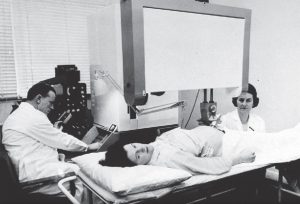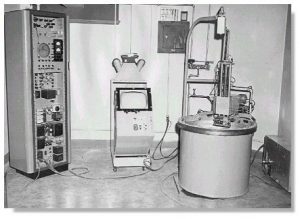
When you start exploring the kind of career paths you can head down after becoming proficient in the science and patient-centered art of diagnostic medical sonography, all kinds of different terms and titles start to emerge describing professionals in different roles where ultrasound is used.
You’ll find many of those terms appearing in official government definitions, job postings and in the titles for professional certifications. You certainly used one of them yourself when you were searching to find this website, and there’s a real possibility it wasn’t the title that sonographers have worked so hard to earn.
Even with a common thread running through the different job titles, professional classifications and roles in which ultrasound is a vehicle for performing non-invasive imaging of internal structures of the body, those different titles and terms you may have come across are no more interchangeable than the organ systems sonographers image.
And more to the point, a couple of those terms have fallen completely out of formal use, now belonging strictly to the body of archival medical text where they now simply give context to the great story of how medical technology and practices have evolved.
And so it goes that the terms used to describe the ultrasound technology that sonographers use should not apply to the sonographers themselves.
We are sonographers; ultrasound technology is the medium by which we produce sonographic images.
Lay Terms Are Finally Catching Up with Proper Professional Titles
If you aren’t already working in the field, the conversation about the professional classifications and titles applied to medical sonography is probably unfamiliar to you. But you got here somehow, searching some word that is probably one of the common, if incorrect, terms that the general public uses when they are trying to find information about the field.
Google search trends aren’t going to tell you anything about the preferences of working professionals in sonography, or the long fight for a title that does justice to their role as healthcare providers who consider patient care to be more central to their work than the technology they use. But looking strictly at the proportion of search queries for the full variety of terms does offer an interesting snapshot of vernacular trends. Going back to the start of search records in 2004, you can see that search queries for sonographer and ultrasound technician were pretty much neck-and-neck through 2008 or so, when ultrasound technician started to build a clear lead.
That lasted through 2014, and after a few more years with roughly equal search interest, in 2018 sonographer clearly started to pull ahead to become the term that is more commonly searched by the general public, marking the point at which the popular term came into alignment with what sonographers actually call themselves.
On the other hand, ultrasound technician didn’t exactly fade into the woodwork… even today somewhere close to half of all searches are still conducted using that term.
While Google hardly gets the final vote on what a profession is or should be called, it does present a fact that websites promoting the profession can’t help but consider: even if a commonly used term is the wrong one, it’s the only way to connect with people who are using it to discover more about the profession.
Diagnostic Medical Sonography By Any Other Name… is Mislabeled

The general classification of medical sonographer applies to professionals who create sonographic images as a core part of their job. Their advanced understanding of both the physics of ultrasound technology and the intricacies of human anatomy make diagnostic medical sonographers valued members of medical and surgical teams, contributing to both treatment and diagnostic procedures in close concert with MDs and other medical staff. Typically, they are further classified by the medical specialty they work within, like OB/GYN sonographer or cardiac sonographer. Just as often they work as generalists, capable of handling all the in-house sonographic imaging functions in smaller medical centers.
As specialists, diagnostic medical sonographers very often focus on imaging a particular organ system or tissue type:
Abdominal sonographer – The abdomen is one of the most fraught regions of the body to explore surgically, extremely vulnerable to contamination and punctures, so this branch of sonography uses ultrasound to create images of the systems and organs in and around the abdominal cavity. Occasionally, they assist in surgeries to provide a better view for surgeons performing procedures.
Breast sonographer – Tissues in the breasts can be of varying densities, but detecting cysts and tumors is important for getting ahead of deadly cancers that take root there. These sonographers are experts at developing non-invasive imaging of breast tissues.
Cardiac sonographer – Also known as echocardiographers, these experts use ultrasound to examine the chambers of the heart, surrounding vessels, and valves, giving doctors a good view of potential issues without requiring invasive procedures.
Musculoskeletal sonographer – These sonographers use strong anatomical knowledge to provide images of muscles, ligaments, joints, and tendons, both to provide guidance during surgical procedures and to offer non-invasive, non-radiological diagnostic options.
Pediatric sonographer – Everything in pediatric medicine is more challenging, and that includes getting good sonograms of the smaller organs and systems of young patients. Pediatric sonographers have to have a good grasp of ultrasound technology as well as a bedside manner that keeps their young patients calm and cooperative.
Obstetric and gynecological sonographer – The strongest association that most people have with sonography are those magical images that come from the womb. They are produced by OB/GYN sonography experts, who not only examine fetal sonograms for potential problems and birth defects, but perform diagnostic work on the female reproductive system in general.
Vascular sonographer – These specialists are also separately referred to as vascular technologists, an exception to the basic rule of “don’t call a sonographer a technologist.” They use ultrasound in imaging of the blood vessels and arteries and the flow, volume, and pressure within them.
Some of the Confusion Comes From Otherwise Reputable Sources
There are a number of organizations and agencies that have some input into what terms end up being used by the public to describe diagnostic medical sonographers, whether official or just as a matter of influence.
The Department of Labor, for instance, identifies medical sonography as an independent role, but as of 2019 still groups the profession in with cardiovascular technologists and technicians despite the different levels of education, expertise, and professionalism implied by the titles.
On the other hand, the Department of Education (DoE) gives Diagnostic Medical Sonography/Sonographer its own category, though even as of this year, it still insists on including the outmoded term “ultrasound technician” along with the preferred title. Presumably, this is done as a way to ensure all prospective students are able to find educational programs leading into the field, even those searching terms that are no longer in formal use.
Then there are the organizations that award certifications in various medical imaging technologies and roles to professionals in the field, like the American Registry for Diagnostic Medical Sonography (ARDMS) and the American Registry of Radiologic Technologists (ARRT).
It’s interesting to note that even though AART clearly prefers to define members, in general, as “technologists,” it still delivers a credential in Vascular Sonography to align with the term preferred by those working in the field… and while ARDMS, uses the term “sonographer” more consistently and always when referring to diagnostic medical sonographers, the certification it grants for the same role instead uses the title Vascular Technologist.
In a well-meaning effort to assure even the most uninitiated of readers that they are in the right place, the AART even goes so far as to reference the term ultrasound technologist in their sonography credentialing page. Even with the best of intentions, this only helps to reinforce the misuse of terms and professional titles.
The American Society of Echocardiography (ASE) and the Society of Diagnostic Medical Sonography (SDMS), an organization we’ll talk more about as having been critical to the establishment and use of the title sonographer in the medical world, are both completely steadfast in avoiding any use of terms like technician or technologist. They do; however, sometimes forgo the term sonographer for the more wordy “Diagnostic Ultrasound Professional.”
With Different Medical Imaging Technologies Come Different Specializations and Titles

Mark 3 Diasonograph in 1960
Source: semanticscholar.org
It’s helpful to consider how different technologies and the different functions of medical imaging professionals interact to create unique jobs, and a variety of titles to describe them. It’s particularly interesting that these very different roles, often incorporating different imaging technology and tools, and requiring different certifications to use them, are sometimes conflated with or mistaken for diagnostic medical sonography.
Cardiovascular Technologists and Cardiographic Technicians – This is a role quite different from the other diagnostic roles that are typically associated with ultrasound technology, but it still seems to be a source of confusion for many exploring related career tracks, and there’s no wonder why. The Bureau of Labor Statistics (BLS) places cardiovascular technologists in the same job category as diagnostic medical sonographers despite the fact that they don’t necessarily always use ultrasound technology, and when they do it’s often for visualizing the placement of invasive diagnostic tools in the body. In fact, invasive diagnostic and treatment techniques like cardiac catheterization is their specialty, making this role very different from the non-invasive nature of diagnostic medical sonography. Cardiovascular technologists are deeply involved in sensitive intravascular insertions such as stent implants and cardiac pacemakers and defibrillators, along with diagnostic monitoring devices such as Holter monitors.
Cardiographic technicians work as a sort of subset of cardiovascular technologists, specializing in electrical monitoring of the heart through electrocardiogram (EKG) to test proper heart function.
Radiologic and MRI Technologists – Also known as radiographers, radiologic and MRI technologists have their own separate BLS classification. They use various radiative technologies such as x-ray and magnetic resonance imaging to perform diagnostic imaging of many of the same systems and organs as sonographers. This category includes the ubiquitous x-ray technologists and techs working with computed tomography (CAT) scan imaging. Until 2002, sonographers were also included in this BLS category.
Nuclear Medicine Technologists – Although these specialists also use radiative technologies, they too get their own BLS category. They prepare and administer a variety of radioactive drugs, which may be used for either imaging or therapeutic purposes, such as in cancer treatments.
Why Diagnostic Medical Sonographers are Neither Technologists nor Technicians
To the average observer, the terms technician and technologist seem to boil down to the same thing. In medicine, however, although they are related, there can be a world of difference between them in terms of education and professional expectations.
Technician jobs are usually those that involve routine, if specialized, work that doesn’t always require an advanced education. These roles are sometimes marked by requiring minimal direct patient contact. Lab techs, for example, run tests on tissue and blood samples using advanced machinery and specialized processes to produce results for clinicians, and rarely come into contact with patients themselves.
Technologist jobs, however, often require at least a four-year degree and involve a level of independence and responsibility above what is expected of technicians. There is a consistent trend of various specializations relabeling themselves as technologists as their field becomes more professionalized and demanding. The American Society for Radiologic Technologists was originally the American Society of X-Ray Technicians, changing the name, in part, because they felt the term technologist better emphasized professionalism and a higher level of education.
Once you get into an actual medical setting, to further the confusion, the natural shortening of both terms to “tech” removes the distinction… you are as likely to call a laboratory technician a lab tech as a radiological technologist a rad tech. This kind of short-hand, however, would rarely be used to describe a medical sonographer.
This is all important context for ultimately understanding why neither the term technician nor technologist accurately describes the kind of patient-centered work diagnostic medical sonographers perform. Many sonographers have put in their time already as radiologic technologists or in other technical roles and view the study and effort they put into earning their certifications in diagnostic sonography as a matter of distinction; it is a more highly regulated and highly paid profession after all.
The very nature of their work and expertise revolves around patient care, and they identify as healthcare practitioners as opposed to putting their technical skills front and center. This is largely what sets the role apart from many others in medical diagnostics. Make no mistake, in many ways the job is no less technical than the other roles we’ve discussed here, and that’s becoming more and more the case every day as the technology itself advances. But for sonographers, the technical aspects of the work are there only to support the ultimate goal of providing personalized, patient-centered care.
And in the most practical sense, there is also the argument about what distinguishes a vocation or technical trade from a profession. Some will say a profession is defined by the number of years you spend in school, with anything requiring less than a bachelor’s degree falling short of what it takes to be considered a professional in any field. Others take on the far more nuanced and difficult side of the debate to defend, arguing that a profession is literally defined by the level of professionalism that those in the field demonstrate, and along with it personal accountability and genuine concern for the outcome of their work and the patients they see.
Understandably, then, practitioners in the field almost universally prefer to be called diagnostic medical sonographers, or just sonographer.
Although much of this might sound like a strictly philosophical distinction, the history of how and why these terms evolved reveals it to be considerably more than that.
A Brief History of Sonography Reveals The Roots of The Many Titles

Howry Apparatus
Source: genesis-ultrasound.com
The word ultrasound emerged in 1911, describing the range of sound frequencies higher than the upper range of human hearing. Two world wars featuring intensive undersea warfare accelerated the development of sound sensing and reflection analysis, and in 1942 two brothers in Austria, a physicist and a neurologist, produced the first sound-based image of an internal organ of the human body, the brain.
By the 1950s, those ultrasound frequencies were being used routinely in the echolocation of structures within the body… most commonly, other bodies, revealing the growth and orientation of fetuses in pregnant women.
But ultrasound also found therapeutic uses—smashing kidney stones, breaking up blood clots, chipping away at tumors.
The practical necessity for a distinction between those modalities led to the term ultrasonography, the process of recording by sound, as a way to describe a profession focused strictly on diagnostic imaging. And since no one likes long words when short words will do, ultra quickly dropped off and by 1952 the process was simply being called sonography. The word describing the product of that process, the sonogram, came around in 1956 according to the Etymology Dictionary.
The word technician had been around for a lot longer by then, describing persons with an expertise in the technicalities of any job, medically-related or otherwise. And in the same year as the first sonogram was generated, that was often being shortened to just “tech” as the profusion of such specialists in the booming war years made it a pretty common role.
Some of the first sonographers referred to themselves as “technical specialists,” and so the earliest association for the profession was established in 1970 as the American Society of Ultrasound Technical Specialists.
But they quickly found the same kind of linguistic shorthand being applied to the title. And that, they felt, undersold the professionalism and commitment to the field that was involved. There are many “techs” found in the modern medical environment… X-ray techs, EMTs, surgical techs, lab techs, and so on. Few of them require anything like the education and expertise necessary to become a professional in ultrasonography.
Joan Baker, one of those original professionals founding the Society, claims to have coined the term sonographer from a combination of SONAR and radiographer, a title more commonly used in her native England for radiologic technologists. And six years after ASUTS was established, the name was changed to what it remains today: the Society of Diagnostic Medical Sonography (SDMS).
Professional and Lexicographical Pedigrees Rarely Follow a Straight Line
English evolves, and so does the fast-paced world of medical imaging, so maybe it’s understandable that there was some struggle to arrive at a universally-accepted term. Sonographer is winning the race with Google, but it took quite a few years to get there. Even now if you look in the U.S. National Library of Medicine’s “S” page of medical terms, you won’t find sonography anywhere, but instead a lonely entry for “Stress Echocardiography.”
Evolution, as we all learn in our science classes, is a messy and roundabout process, but in the end a necessary one. In language, as in biology, there are often a few attempts at finding a new iteration before one finally fits the bill. And that’s a good thing; going for a drive in your shiny new horseless carriage just doesn’t have quite the right ring to it after all.
So the history that has led to the current state of affairs may simply have been unavoidable: ultrasonography was a valuable coinage to label a new and lifesaving technology, and sonographer offers a clear reference to a professional working with that technology… both of them words that wouldn’t exist in a less flexible language. But even within the field in those early years, it wasn’t always clear which terms were going to become preferred.
Innovation can be exciting, but change doesn’t always ask for permission. In both medical ultrasound and in language, these changes can occur even in a single generation. In the 1950s, calling someone a geek was an invitation to getting your nose flattened. By the 1990s, it had become a term of admiration and recognition of expertise among computer scientists and other IT aficionados.
Words aren’t dead things, laid out once and forever in a dictionary somewhere, holding the same meaning until the end of time. Even in one particular era, not all words are the same to all people.


*Google analytics 30-day regional search trends for Nov 10-Dec 9, 2020
You can see these differences even today. With the world of high tech becoming cool and prestigious, you can see signs that the newer generation of sonographers may take some pride in being referred to as techs or technologists. In online message boards, where they chat with one another, sonographer is still the most common title. But they also refer to one another as tech and technician interchangeably and without stigma. You can even find evidence of this in the Google data… in the tech hubs of the West Coast and elsewhere in the country, “ultrasound technician” is more commonly used, even as sonographer emerges as the most frequently used term overall and dominates in much of the rest of the country.
The Struggle to Mark Sonography As a Profession of Distinction

Anyone just entering a new profession may not always be aware of the battles their predecessors fought to establish the acceptance, credentials, and respect that now seem to automatically accrue to it. Debates over titles may seem a lot less important to eager new students than the work that lies ahead for them; but the work that went into establishing those titles is something they should feel reverence for.
Members of SDMS lobbied hard to have the Department of Labor recognize the profession separately from nursing and radiologic imaging, which is the only reason that diagnostic medical sonographer even exists as a distinct position in that catalog of listings today. The hard work of pioneers like Stephen McLaughlin and Terry DuBose leading up to that 2002 change not only ensured that strong certification and professional standards were established for sonography professionals, but also that official job classifications correctly reflected those standards. It’s important for a profession to be recognized independently and for members of that profession to be credited for their education, training, and expertise.
And even beyond that, titles can hold a certain strength in and of themselves. There’s little doubt that sonography would be as respected or as professional or as well-paying a field as it is today without those early pioneers drawing that line somewhere, and without their followers holding it firmly.


